Introduced in 1983, initially the engines
available in the 33 were as in the Alfasud, 1351cc (with either a single
carburettor (79bhp) or twin units (86bhp)) and 1490cc (85bhp or 95bhp with
a single and twin carburettors respectively), the latter also in Quadrifoglio
form (or Cloverleaf). Next came the above mentioned estate, with a body
built by Pininfarina and finished by Alfa, it also featured a selectable
four wheel drive system developed by Subaru. 1985 saw minor modifications
to the range, such as the fitment of the twin carburettors on the Gold Cloverleaf too.
A mild facelift, both inside and out was
carried out in 1987, including the introduction of a 1712cc engine (118bhp)
and the discontinuation of the 4WD system. The estate, now with front wheel
drive only, was renamed the 'Sportwagon'.
A diesel engine was also offered in the
33, this being a 1779cc turbocharged and intercooled unit from VM with
a power output of 83bhp.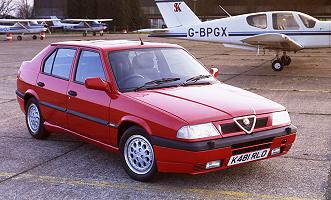 The
Alfasud
had taken Alfa Romeo into new territory - small front wheel drive cars,
but by the early 1980's it was getting old and needed to be replaced. The
replacement, the 33, used almost identical mechanical parts with a new,
more modern body designed by Pininfarina. Available only with five doors,
the only body variant was the SportWagon, a 'lifestyle' estate body, no three
door 33 or coupe ever being built.
The
Alfasud
had taken Alfa Romeo into new territory - small front wheel drive cars,
but by the early 1980's it was getting old and needed to be replaced. The
replacement, the 33, used almost identical mechanical parts with a new,
more modern body designed by Pininfarina. Available only with five doors,
the only body variant was the SportWagon, a 'lifestyle' estate body, no three
door 33 or coupe ever being built.
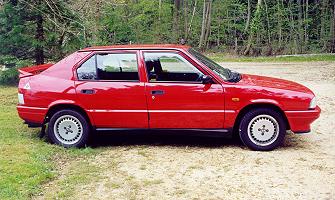 The third series, released in 1990, featured a heavily revised exterior styling,
with new front and rear end treatments designed to follow the new 'corporate'
look from the 164. The interior was also revised, and a 16V version of
the 1712cc unit, with 137bhp, arrived. In the Permanent 4 this engine was
coupled with an intelligent four wheel drive system which normally put
95% of the drive to the front wheels, but could, when needed, put up to
65% through the rear. Fuel injection also replaced carburettors on the
1700 8V (110bhp) and 1500 (95bhp) engines and catalytic converters were fitted.
The third series, released in 1990, featured a heavily revised exterior styling,
with new front and rear end treatments designed to follow the new 'corporate'
look from the 164. The interior was also revised, and a 16V version of
the 1712cc unit, with 137bhp, arrived. In the Permanent 4 this engine was
coupled with an intelligent four wheel drive system which normally put
95% of the drive to the front wheels, but could, when needed, put up to
65% through the rear. Fuel injection also replaced carburettors on the
1700 8V (110bhp) and 1500 (95bhp) engines and catalytic converters were fitted.
Technical Details
| Driveline | longitudinal engine at front with front wheel drive or four wheel drive |
| Suspension | front : MacPherson strut with telescopic dampers and coil springs plus anti-roll bar
rear : dead beam axle with telescopic dampers and coil springs, located by Watts linkages and a panhard rod wheelbase : 2450mm (Estate versions : 2455mm) front track : 1364mm to 1392mm (depending on model) rear track : 1359mm to 1364mm (depending on model) |
| Brakes | front : discs (ventilated on some models)
rear : drums or discs handbrake operating on the rear via cable dual hydraulic circuit with servo assistance |
| Gearbox | 4 and 5 speed manual |
| Steering | Rack and pinion
power assistance on some models |
| Kerb weight | 1986 models : 1.3 : 890kg; Green Cloverleaf : 890kg; 1.5 4x4 : 970kg
1990 models : 1.3 : 910kg; Green Cloverleaf : 910kg; 1.5 4x4 Sportwagon : 990kg |
Click here for a cutaway of a 33 Permanent 4
Performance
| model | max speed | 0-100km/h | standing km | braking dist from 100km/h |
| 33 Sportwagon 1.3S (1988) | 176 km/h | 11.3 sec | 33 sec | 50.2 m |
| Sportwagon 1.7 QV (1988) | 196 km/h | 9.2 sec | 30.6 sec | 46.1 m |
| 1.7ie (1988) | 187 km/h | 9.9 sec | 31.4 sec | 48.7 m |
| QV 16V (1990) | 209 km/h | 8.5 sec | 29.4 sec | 48.6 m |
Tuning
There are three main areas to concentrate
on, the engine (and transmission), the brakes and the suspension and then
various other details. These three should be done together since they complement
each other, not all of one and none of another !
1. The engine.
Before modifying the engine it is worthwhile
filling it with a good quality synthetic oil and fitting new spark plugs.
An engine oil additive may also be used.
The first improvements are relatively simple.
The air filters can be replaced for aftermarket items which will help the
engine breathe more freely, the type which completely replace the original
airbox are best (one on each carburettor), and the exhaust can be replaced
for one which will restrict the exit of the gases less. The manifold from
the 1700 can be used on earlier cars to give a larger bore manifold.
If it is a single carburettor model, then
fitting twin carburettors will improve things, on those models with twin
carburettors as standard On fuel injected cars you can either buy
an off-the-shelf module (if you can find one) or buy a general one and program it to suit.
Other things to do should include fitting
a cold air intake, two large diameter pipes (minimum 5cm) to provide air
from outside the engine bay to the air filters. The exhaust manifold can
also be lagged with thermal cloth or tape to keep the exhaust gases hotter
(and thus reduce back pressure). This may also help reduce the temperature
of some components nearby (eg brakes).
Further modifications require the machining
of the cylinder headand/or cylinder block (which will not be dealt with
here since it is not normally a DIY job) after which it may be worth fitting
an oil cooler. If overheating is a problem due to the increased power output
then a small hole can also be drilled through the plate in the thermostat.
Regarding the transmission the main requirement
is to uprate the clutch to handle the increase in power and torque achieved
though the engine modifications. Friction plates can be purchased with
improved materials and heavier duty pressure plates are also available.
Whilst doing this it is worthwhile lightening the flywheel.
2. The brakes.
It is relatively easy to replace the brake
discs with drilled and grooved items, and the pads for a harder compound.
The latter should not be too hard (ie no race pads on the road) or they
will not function effectively at the normal 'road' operating temperatures.
Stainless steel braided flexible hoses will improve the pedal feel and
reduce the chance of damage whilst DoT5 fluid (not silicon) will For those cars with drums at the rear,
it is possible to fit the discs fitted to the rear of some models.
If more serious braking is required the
next modification would be to increase the disc size. It is possible to
use larger discs with a bracket allowing use of the production callipers,
or alloy four pot callipers can be fitted.
In order to improve the balance of the
car under braking it is desireable to be able to adjust the balance of
braking from front to rear (and vice versa). This can be accomplished by
fitting a bias valve in the line to the rear brakes, usually in a position
so that it can be reached from the drivers seat.
3. The suspension.
The easiest improvement,and the one which
will probably bring the single most noticeable change, is to replace the
dampers and springs. Fitting lowered springs will improve the cornering,
but must be fitted together with shortened stroke dampers, or else the springs
may unseat ! Top adjustable dampers are compromised, but are good for road
and track day cars since it allows the suspension to be adjusted between
these two, rather different, requirements. Coil over units add more adjustability
and can be purchased outright, or can be made from standard dampers by
welding a threaded sleeve to the standard tube.
There are then two other main suspension
aims; to reduce the flexiblity in the suspension and to increase the stiffness
of the car, Into this category also fall the choice
of wheels and tyres. With an increase in power it can be necessary to fit
larger tyres (thus requiring larger wheels) but the temptation to fit the
biggest possible should be resisted. Consideration should be given to fitting
a wider tyre on the front (since they provide traction and steering) but
keeping the standard, or a wider but not as wide as the front, tyre at
the rear. This will improve the balance of the car. As with all FIAT, Alfa
Romeo and Lancia cars, used wheels are rarely a problem to find - 6x14"
rims with 195/60-14 tyres seem to fit and function well.
4. other things.
Other modifications worth considering include
fitment of a shift light (and rev limiter if there is not one as standard),
higher power bulbs in the headlights (if you are going to go faster you
need to see further) and installation of a quicker steering rack.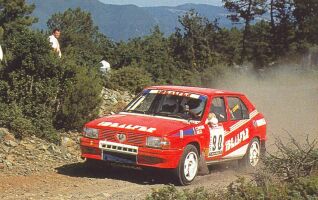 (36
IDFs were the factory fitted units, from Weber or Dellorto) then the replacement
of the standard 36 carburettors with 40 or 44 units is simple - only the
inlet manifolds need opening out slightly. An electric fuel pump is advisable
with these carburettors, if used with a pressure regulator the return line can be deleted.
(36
IDFs were the factory fitted units, from Weber or Dellorto) then the replacement
of the standard 36 carburettors with 40 or 44 units is simple - only the
inlet manifolds need opening out slightly. An electric fuel pump is advisable
with these carburettors, if used with a pressure regulator the return line can be deleted.
The high tension leads can also be replaced with performance ones.
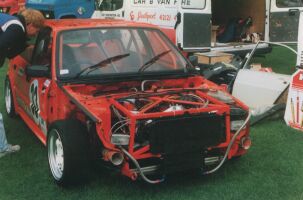 increase
the temperature at which it can operate effectively. If the brakes are
getting too hot the dustguards can be removed and/or ducts fitted, taking
air from behind the front bumper.
increase
the temperature at which it can operate effectively. If the brakes are
getting too hot the dustguards can be removed and/or ducts fitted, taking
air from behind the front bumper.
 both
of which aim at more accurate control of the wheel movement. To reduce
the flexibility it is possible to fit nylon bushes instead of the normal
production rubber items, or if perfection is desired the suspension can
be fitted with metallic bearings (rose joints / rod ends). Spherical bearing
top mounts can also be used. To stiffen the car it is most popular to fit
strut braces. These can be fitted to the front and rear, although given
the design of the 33 it is questionable whether a front brace is neccessary.
For more extreme cases a rollcage can be fitted.....
both
of which aim at more accurate control of the wheel movement. To reduce
the flexibility it is possible to fit nylon bushes instead of the normal
production rubber items, or if perfection is desired the suspension can
be fitted with metallic bearings (rose joints / rod ends). Spherical bearing
top mounts can also be used. To stiffen the car it is most popular to fit
strut braces. These can be fitted to the front and rear, although given
the design of the 33 it is questionable whether a front brace is neccessary.
For more extreme cases a rollcage can be fitted.....
Maintenance
Mechanically
the Alfa 33 is a reasonably robust vehicle as long as it is well serviced.
Items which should be closely monitored are the timing belts, and their
covers (dirt ingress can lead to failure, with unpleasant consequences)
and (like most older Italian cars) everything electrical - especially earth connections !
It is worth using synthetic oil, and an
oil additive (such as 'Slick 50') is also recommended.
Buying / Selling
Tidy inside the car thoroughly : hoover
the floor, empty all pockets, ashtrays (wash), glove compartment etc...,
wipe the trim with a damp cloth, give the cockpit a good airing to get
rid of any odours ! Reset the trip meter to 00000 - it is a pleasant (subconcious) surprise.
If the car has been standing give it a
good run - this will clear out the engine (reduce exhaust smoke), put a
shine on the brake discs and loosen up any joints that may otherwise make some noises.
'Back to black' products are very effective
at temporarily restoring bumpers and trim. This makes a big difference
to any car. Do it a week before you expect people to view the car, otherwise it may be a bit too obvious !
Jetwash under the car, especially under
the engine and in the wheelarches. The prospective buyer may be an enthusiast,
and this makes it easier for them to see what they want to check.
Obviously wash the car and clean the windows !
If you are going to buy a car always check the following :
On 33's it is very neccessary to check
the bodywork. Pay special attention to the wheelarches (inside if there
is no plastic splash guard), suspension and engine mounts, sill, door pillars
(check for sagging doors), scuttle panel and the floor (doors, bonnet and
boot/hatch are also susceptible, but are more easily replaced). If a sunroof
is fitted check around the edge for signs of rust.
Check for a damp carpet or the presence
of mould - if the carpet is damp then the floor is almost certainly corroded.
Check the main electrical functions - wipers,
windows, etc... try putting the main beam and wipers on at the same time.
Check the headlight reflectors for rust.
Check for excessve wear in the rear suspension bushes.
Check the brake pedal does not go to the
floor if pressed hard for a long time and check the gearchange for clean engagement.
The engine should be run up to temperature,
check the exhaust for smoke, the condition of the breather (look for mayonnaise),
the Check tyre wear, uneven patterns could imply a bent chassis.
Always take the car for a test drive. Check
that the car tracks in a straight line with no steering input and remains
in a straight line under braking. Find a large open area and complete several
lock to lock turns (also in reverse), listening for any noises. Try the
handbrake when moving - seized rear callipers will mean uneven braking or no braking.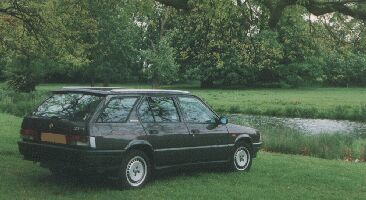 Some tips to do before selling :
(they may seem obvious, but most people don't do them and thus are in a
weaker bargaining position)
Some tips to do before selling :
(they may seem obvious, but most people don't do them and thus are in a
weaker bargaining position)
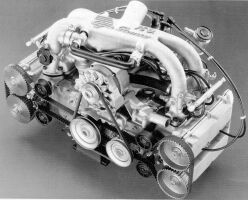 Check that there are no mismatching panels, large areas of discolouration or
signs of fresh paint. Compare the paint colour in the engine bay with that of the exterior.
Check that there are no mismatching panels, large areas of discolouration or
signs of fresh paint. Compare the paint colour in the engine bay with that of the exterior.
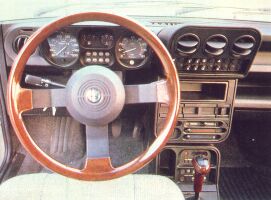 condition
of the oil filler cap (again white deposits can indicate head gasket or
other serious problems) and the colour of the coolant (preferably not brown!).
If the car has an oil pressure guage this should not drop below 1 bar at
idle, and should be around 3 to 4 bar at speed. Listen to the noise of
the engine, then depress the clutch and engage first gear. Whatever noise
has disappeared was coming form the gearbox, what remains is from the engine.
Check the colour of the oil using the dipstick. A golden-brown is best,
darker brown is ok, but thick and black should be avoided.
condition
of the oil filler cap (again white deposits can indicate head gasket or
other serious problems) and the colour of the coolant (preferably not brown!).
If the car has an oil pressure guage this should not drop below 1 bar at
idle, and should be around 3 to 4 bar at speed. Listen to the noise of
the engine, then depress the clutch and engage first gear. Whatever noise
has disappeared was coming form the gearbox, what remains is from the engine.
Check the colour of the oil using the dipstick. A golden-brown is best,
darker brown is ok, but thick and black should be avoided.
Links
A private Alfa 33 website
Another 33 website
An excellent Alfa 33 website including register
An excellent Alfa 33 Club site in the Netherdlands (in Dutch)
There is also a list of all our picture galleries (including museums,
motorshows and various events).
Wallpapers/Desktop Backgrounds of numerous Alfa Romeo's also available to download.
There are also various statistics regarding production and sales.
33 comment form
Your Comments
1990 Alfa 33 1.7 green cloverleaf
£375, worth every penny plenty of problems but so much fun fantastic
motor good safe handling lowering helps getting the power down in slow
corners. would I but another 33?? Pounds per smiles. I would have to say
yes lets make it a 16 Valver this time please (Phil S, UK)
It's a great car, our relation
is more powerful than a relation with a women...I love her. (Seb)
I own a 1989 1.7 QV which has done 170.000Km and is running fine, no problems ( not even electrical problems ),
great pure fun to drive. I'll keep it for as long as I can! (Luis S, Portugal)
Of the many Alfas I own and have owned this (`87 TI 1.5)is the worst Alfa I`ve owned.
Although based on the Alfasud, it is not an Alfasud`s a****** but it is nonetheless a practical,economical car that is simple to
fix and service and is powered by that superb boxer motor, and even a poor Alfa to an Alfa enthusiast is better than a Nissan, or
Toyota etc which is the choice in NZ. One of the worst Alfas produced (in my opinion). (Richard J, New Zealand)
An awesome machine, my Q4!! It has a wonderful orginal sports look and Golf & 150 HP Megane Coupé killing performance!!
I Have an Alfa Romeo 1.7 16v Boxer Quadrifoglio,1990, and i love it.Very powerful,excellent top speed,incredible aceleration,nice handling,with a beutiful sound of the engine when i press the throtle.It´s my car,and i love it. (Henrique, Portugal)
I own a 33 QV since 1987. There is only one word to describe this car: reliability! It's a great fun to drive (perfect road-holding and magical engine-sound). Pleasant at every little aspect, and I'll keep it running as long as I can. (JL, Spain)
I've had a third model 1.5 33 with twin carburetors and 105 hp. It was fantastic to drive and had superb handling. Had to sell it.... ;( But i will buy a P4 some of these days! This machine gave me more fun than my BMW 320 Ci nowadays! Believe me! (Ricardo, Portugal)
I had a '92 33 1.7 16V Boxer QV. It was my first car! And I loved! It was very loud, everything rattled! (2nd gear - kchchch! ouch!) But it made so much fun to drive it!
The engine can shout like a beast and the acceleration is great! (I ate much of VW Golfs!)
Now I have a 156 and there's no way to compare it with the 33! But sometimes I miss my "Golf-Killer"! Maybe I'll buy one again someday. Just for the pleasure!
I have got an Alfa 1.7 IE 1990 since only two months but this car is a pleasure to drive. Comfortable,terrific engine with an incedible sound.You will of
course get more fun to drive on long distances(in town it's very boring).Be ware on wet,due to its power it( I have not experimented yet )can spin very
easily.Have fun!
hi to all 33 fans! ive got a 90 16v qv (same as white one pictured) and i love it top engine top handling supa looks ! still the best alfa!! (Rod, Australia)
Use the buttons at the top to navigate
further, or
Copyright © 2000 to 2008 CarsfromItaly
![]() For books on Alfa Romeo see our Online Bookstore
For books on Alfa Romeo see our Online Bookstore
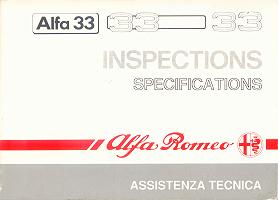 A real pleasure to drive
and to look at, not expensive at all, practical! Be careful when shifting
gears though. You like driving and you have a limited budget? This is your
car! (Peter L, Belgium)
A real pleasure to drive
and to look at, not expensive at all, practical! Be careful when shifting
gears though. You like driving and you have a limited budget? This is your
car! (Peter L, Belgium)
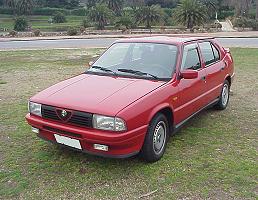 I own 1992 Alfa 33 1.7 iE - real pleasure to drive,the one of most beautiful car in the world, you can keep your M3s(Vladi, Bulgaria)
I own 1992 Alfa 33 1.7 iE - real pleasure to drive,the one of most beautiful car in the world, you can keep your M3s(Vladi, Bulgaria)
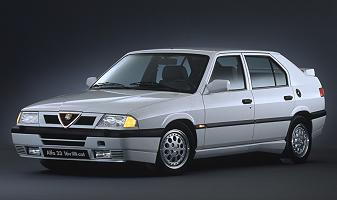 Heya, I had a 33 boxer 16v a few months ago,but a friend
smashed it..so I bought a BMW 325i E30, quite nice..but guess what, I'm
making a swap, a red Alfa 33 boxer 16v, with my bimmer. I missed the Alfa
so much,I swapped it without any payment or anything (the BMW is worth a
little more than the Alfa, moneywise ONLY..)All my friends that tried
driving it said:"sh**,where can I get one of those?"or"I'm thinking of
bying one now...".First of all,the driving position..in the bimmer,
you're comfortable, feeling relaxed..but that's not what I'm looking
for,my driving is nothing that looks like nice and relaxing.The Alfa has
this unique, sporty driving position, where at least you don't fall
asleep while driving at night!!;)Then,second of all,the fuel
consumption..don't think anybody needs details! Thirds,repair- and
maintenance costs..Then, the handling of the 33 is much better
(sportwise) than the 325,you won't really need strut bars in a 33, but
in the bimmer,it was almost a must! And don't try to but a big stereo in
a bimmer,it's really a bad car for that: aluminium plate on the back of
the backseat,trunk inderectly connected to the cabine,plus the sides of
the trunk are so long,that they become too soft when bass is
pumping..The sound of the 16v boxer engine is a lot nicer than the 325
six! The 325 is one of the most boring sounds ever heard!At last,even
though the Alfa doesn't have the reputation of a solid "stainless" car,I
must say,it's a rock compared to the bimmer.I had several problems in 3
months with the bimmer,where the Alfa didn't have a single problem for a
year.Besides,the 325 isn't really quicker than the 33,which surprised me
a lot(170hp vs 132hp)..but I guess it was because of the weight
difference plus a quite heavy flywheel on the bimmer.The only difference
was far higher power under 4000 rpm in the 325, and a total lack of it
in the 33 ;( Let's see what we can do about that, what about a
compressor?? (Torsten, Luxembourg)
Heya, I had a 33 boxer 16v a few months ago,but a friend
smashed it..so I bought a BMW 325i E30, quite nice..but guess what, I'm
making a swap, a red Alfa 33 boxer 16v, with my bimmer. I missed the Alfa
so much,I swapped it without any payment or anything (the BMW is worth a
little more than the Alfa, moneywise ONLY..)All my friends that tried
driving it said:"sh**,where can I get one of those?"or"I'm thinking of
bying one now...".First of all,the driving position..in the bimmer,
you're comfortable, feeling relaxed..but that's not what I'm looking
for,my driving is nothing that looks like nice and relaxing.The Alfa has
this unique, sporty driving position, where at least you don't fall
asleep while driving at night!!;)Then,second of all,the fuel
consumption..don't think anybody needs details! Thirds,repair- and
maintenance costs..Then, the handling of the 33 is much better
(sportwise) than the 325,you won't really need strut bars in a 33, but
in the bimmer,it was almost a must! And don't try to but a big stereo in
a bimmer,it's really a bad car for that: aluminium plate on the back of
the backseat,trunk inderectly connected to the cabine,plus the sides of
the trunk are so long,that they become too soft when bass is
pumping..The sound of the 16v boxer engine is a lot nicer than the 325
six! The 325 is one of the most boring sounds ever heard!At last,even
though the Alfa doesn't have the reputation of a solid "stainless" car,I
must say,it's a rock compared to the bimmer.I had several problems in 3
months with the bimmer,where the Alfa didn't have a single problem for a
year.Besides,the 325 isn't really quicker than the 33,which surprised me
a lot(170hp vs 132hp)..but I guess it was because of the weight
difference plus a quite heavy flywheel on the bimmer.The only difference
was far higher power under 4000 rpm in the 325, and a total lack of it
in the 33 ;( Let's see what we can do about that, what about a
compressor?? (Torsten, Luxembourg)